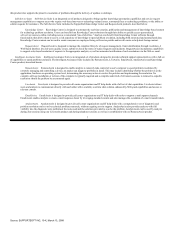Support.com 2007 Annual Report Download - page 21
Download and view the complete annual report
Please find page 21 of the 2007 Support.com annual report below. You can navigate through the pages in the report by either clicking on the pages listed below, or by using the keyword search tool below to find specific information within the annual report.
locations. As a result, we expect to continue to use significant cash and incur increased operating expenses to support this initiative, including costs associated
with our customer support agents, costs to acquire technology and infrastructure to support our consumer business, promotional costs associated with reaching
consumers, and costs of obtaining personnel with the necessary consumer expertise. These investments may not yield increased revenue to offset these expenses.
Furthermore, this new business initiative, if not favorably received by consumers, could damage the reputation of our corporate enterprise business as well as
strain our management, financial and operational resources necessary to maintain our corporate business. The lack of market acceptance of such efforts or our
inability to generate satisfactory revenue from such expanded services would have a material adverse effect on our business, prospects, financial condition and
operating results.
If we fail to manage our customer support agents efficiently and in a manner that provides an adequate level of support for our customers, our
reputation and revenues could be harmed.
Our plans for our consumer business depend in part on our ability to increase the number of our customer support agents in order to satisfy the demand for
our consumer services. Any material disruption or slowdown in our service delivery infrastructure and systems resulting from labor disputes, telephone or
Internet failures, power or service outages, natural disasters or other events could make it difficult or impossible to provide adequate customer service and
support. Further, we may be unable to attract and retain adequate numbers of competent customer support agents, which is essential in creating a favorable
interactive customer experience. If we are unable to continually provide adequate staffing for our service delivery operations, our revenue and reputation could
be seriously harmed.
Because a small number of enterprise customers have historically accounted for and may in future periods account for substantial portions of our
revenue, our revenue could decline because of delays or losses of specific customer orders.
A small number of enterprise customers have historically accounted for, and may in future periods account for, substantial portions of our revenue. For the
fourth quarter of 2007, one customer accounted for 18% of our total revenue. For the year ended December 31, 2007, the same customer accounted for 18% of
total revenue. In 2008, we are likely to continue to derive a significant portion of our enterprise revenue from large transactions with a limited number of
customers. Therefore, our revenue could decline because of the loss or delay of a single enterprise customer order. Additionally, we may not obtain new
customers. The failure to obtain significant new customers, particularly customers that purchase perpetual licenses with up-front payments, the loss or delay of
significant customer orders or the failure of existing customers to pay ongoing fees when due would harm our operating results.
Our sales cycle in our enterprise business is lengthy and if revenue forecasted for a particular quarter is not realized in that quarter, significant
expenses incurred may not be offset by corresponding revenue.
Our sales cycle for our software in our enterprise business typically ranges from three to nine months or more and may vary substantially from customer to
customer. The purchase of our products and services for corporate customers generally involves a significant commitment of capital and other resources by a
customer. This commitment often requires significant technical review, assessment of competitive products and approval at a number of management levels
within a customer's organization. While our enterprise customers are evaluating our products and services, we may incur substantial sales and marketing
expenses and spend significant management effort to complete these sales. Any delay in completing sales in a particular quarter or the failure to complete a sale
after expending resources during the sales cycle could cause our operating results to suffer.
17
Source: SUPPORTSOFT INC, 10-K, March 13, 2008
























